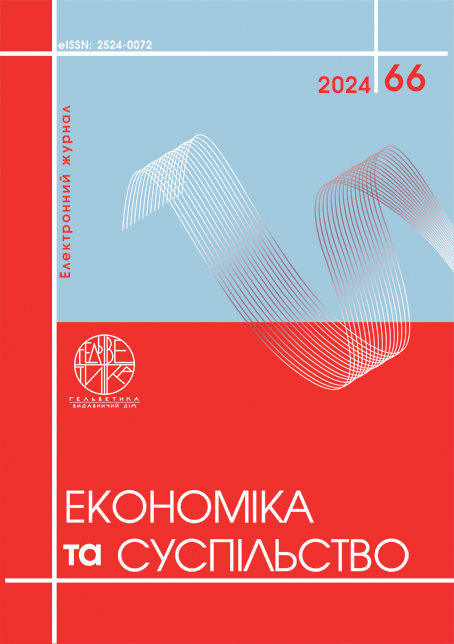DYNAMICS OF THE UKRAINIAN BANKING SYSTEM’S ATTRACTION AND USE OF CASH SURROGATES
Abstract
This study is devoted to the analysis of transformations in the use of monetary surrogates within the Ukrainian banking system from 2015 to 2023. Through an extensive examination of financial data, key factors driving the rising prevalence of electronic money and cryptocurrencies have been identified. This phenomenon unfolds against a backdrop of profound technological shifts and economic volatility, compounded by regulatory challenges. The findings underscore a strong interconnection between technological advancements, changes in consumer behavior, and the evolution of the regulatory framework. A notable increase in the volume of electronic money transactions, coupled with the significant expansion of the cryptocurrency market, points to a paradigm shift from traditional banking services towards novel financial instruments. Specifically, electronic money, cryptocurrencies, and digital tokens are emerging as prominent alternatives to conventional currency, offering users avenues for conducting transactions and preserving value amid economic instability. The research also provides an in-depth analysis of the regulatory hurdles confronting financial institutions and government agencies, particularly regarding adherence to anti-money laundering (AML) protocols and know-your-customer (KYC) regulations, alongside the imperative to safeguard consumer rights amid heightened cryptocurrency market volatility. Furthermore, this study addresses the potential long-term ramifications of the proliferation of monetary surrogates on Ukraine’s banking system, including shifts in conventional banking practices, potential risks to financial stability, and implications for monetary policy. Despite notable progress in the integration of new financial technologies, several unresolved challenges persist, particularly concerning the provision of adequate regulatory support for innovation while maintaining the stability of the financial system. In conclusion, this research offers a valuable contribution to the understanding of how technological development and socio-economic changes are reshaping financial systems in emerging economies, with a particular focus on Ukraine. The insights derived from this study may prove instrumental for policymakers and financial institutions as they navigate the evolving conditions and challenges of a rapidly transforming financial landscape.
References
Bouveret, A., & Haksar, V. (2018). What Are Cryptocurrencies? Finance & Development, 55(2), 26–27.
Plastun, A., Makarenko, I., Yelnikova, Y., & Sheliuk, A. (2020). Crisis and financial data properties: A persistence view. Journal of International Financial Markets, Institutions and Money, 69, 101289.
Demirgüç-Kunt, A., Klapper, L., Singer, D., Ansar, S., & Hess, J. (2018). The Global Findex Database 2017: Measuring financial inclusion and the fintech revolution. World Bank Publications.
Kuzheliev, M., Rekunenko, I., Nechyporenko, A., & Nemsadze, G. (2019). Improvement of the Approaches to the Assessment of the Financial Stability of Banking System. Financial and Credit Activity: Problems of Theory and Practice, 2(29), 4–14.
Houben, R., & Snyers, A. (2018). Cryptocurrencies and blockchain: Legal context and implications for financial crime, money laundering and tax evasion. European Parliament.
Shapovalova, A., Pozhar, Y., & Kostyuchenko, N. (2021). The Regulatory Framework for Electronic Money and Cryptocurrencies in Ukraine: Current State and Development Prospects. Financial and Credit Activity: Problems of Theory and Practice, 1(36), 4–13.
Baur, D. G., Hong, K., & Lee, A. D. (2018). Bitcoin: Medium of exchange or speculative assets? Journal of International Financial Markets, Institutions and Money, 54, 177–189.
Dabrowski, M., & Janikowski, L. (2018). Virtual currencies and central banks monetary policy: challenges ahead. European Parliament.
Denysenko, T. V. (2022). Problemni aktyvy v systemi upravlinnia ryzykamy komertsiinykh bankiv [Problem assets in the risk management system of commercial banks]. Ekonomika i derzhava, (6), 52–56. DOI: https://doi.org/10.32702/2306-6806.2022.6.52
Holovko, N. I., & Mishchenko, V. I. (2021). Problemy upravlinnia problemnymy aktyvamy v ukrainskykh bankakh [Problems of managing problem assets in Ukrainian banks]. Visnyk NBU, (4), 15–23.
Kravchenko, I. O. (2021). Stan i perspektyvy rozvytku bankivskoi systemy Ukrainy v umovakh kryzovykh yavyshch [State and prospects of development of the banking system of Ukraine in crisis conditions]. Finansy Ukrainy, (3), 5–12. DOI: https://doi.org/10.33838/2310-0004.2021.3.5-12
Mishchenko, V. I. (2022). Upravlinnia problemnymy aktyvamy v umovakh finansovoi nestabilnosti [Management of problem assets in conditions of financial instability]. Bankivska sprava, (1), 30–39.
Pustoviit, R. F., & Lysenko, R. V. (2022). Tendentsii upravlinnia problemnymy aktyvamy v bankakh Ukrainy [Trends in the management of problem assets in banks of Ukraine]. Ekonomika: realii chasu, (1), 41–50.
National Bank of Ukraine (2023). Analityka shchodo problemnykh aktyviv.

This work is licensed under a Creative Commons Attribution 4.0 International License.


